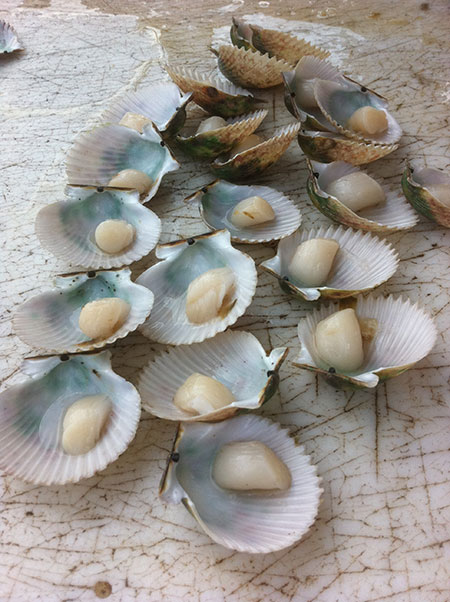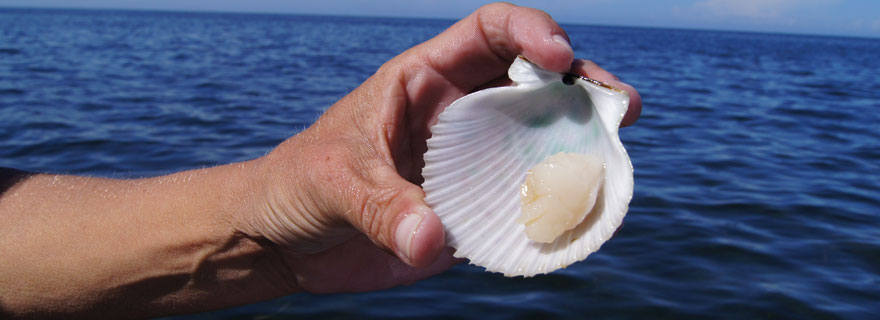As we leave the dock, it’s obvious that we are far from alone. From late June to mid-September Florida’s recreational scallop season is in full swing and boats are launching for the journey to the Gulf of Mexico. There is excitement in the air. We are on our way to one of Florida’s most fertile scalloping grounds.
Out on the Gulf, north of Tampa Bay, there are miles and miles of shallow grass flats. This is where we will be diving for live scallops (picture the Shell Oil scallop) that can fit perfectly into the palm of your hand and are one of Florida’s tastiest seafood delicacies.
This is an annual tradition for many families and friends as they gather for a day of fun on the water. And, oh, yeah, did I mention that today’s catch will be tonight’s dinner?
We slowly motor along the Homosassa River, passing homes that are unmistakably “old Florida.” We pass Shelly’s Fish Market, an old-timey fish shack that sells freshly caught seafood “off the dock.” Next to Shelly’s is a fleet of weather-beaten fishing vessels. And in the distance are rows of stacked stone crab traps. We pass brightly colored “fish camp” homes with screened porches, painted buoys and fishnets draped over fences. There is no question that this community is all about being “on” or “in” the water.
As the homes fade away, the landscape begins to become more natural. After all, this is the Nature Coast. We cruise through a labyrinth of marshes dotted by islands of the state tree, the Sabal Palm. This Florida wilderness is distinctly unique, with its undeveloped wild and scenic ecosystem. Hammocks and mangrove islands dot the landscape and we pass a giant osprey nest nestled into a channel marker. We gawk at the nest, really a work of art particularly when the newborn babies peak out of the sticks and twigs and branches that form the nest.
As we continue westward along the river, the captain increases speed and cranks up the radio. We all grin as we enjoy the music but it is the dolphin that gets our attention. It follows us, jumping in and out of the waves and we even manage to get some good photos on our cell phones.
Once out on the Gulf of Mexico, it’s easy to spot the scalloping grounds. A slew of boats are anchored, dive flags are flying while snorkels are skimming the surface.
The sounds of summer fun are in the air – much like a saltwater tailgate party.
One thing is certain. Everyone is having a good time.
But who wouldn’t be happy out here? The early morning water is perfect, glassy and perfectly calm. Without a cloud in the sky, the horizon and sky meet seamlessly.
And down below, the crystal clear water provides a perfect view of nature’s aquarium, where we watch billowing pastures of manatee grass interspersed with patches of sand. The grass is where the scallops are hiding. Often they sit on top of the grass, but are easiest to spot where the sand meets the edge of the grass beds.
As we hang over the side, the captain shuts off the engine and allows the boat to gently drift over the grass beds, while we watch for scallops. The depth ranges from four to six feet deep. When enough scallops are spotted in one area, the captain will anchor the boat to begin our first dive.
We put on our diving gear – masks, snorkel, fins, mesh dive bags and gloves. The captain instructs us to use the ladder or jump into the water reminding us to swim on the water’s surface, peering below for scallops. Sometimes the mollusks are within reach, otherwise, we dive under the surface to grab them.
 It will be the neon-blue eyes popping through the scallop opening that catch our eyes. We grab them, placing the delectable mollusks into our scallop bags much like a saltwater Easter egg hunt.
It will be the neon-blue eyes popping through the scallop opening that catch our eyes. We grab them, placing the delectable mollusks into our scallop bags much like a saltwater Easter egg hunt.
Add to that the fun of being in an underwater museum. You are likely to see starfish, coral, seahorses, turtles, fish of all kinds – needlefish, pinfish, sea trout and minnows – and so much more. Seagrass beds are very productive ecosystems that support an abundance of sea life. You may even see an occasional manatee swim by munching on the grasses on its way to a local spring.
But be forewarned about scalloping. This sport is addictive. The more you find, the more you want. But there are limits. Two gallons of whole scallops are allowed per person or one pint of scallop meat per person is the law.
Once scallops are brought to the boat, they are placed on ice and cleaned. An oyster knife helps pry open the scallop and remove the precious white meat.
Back on shore, many local restaurants will cook the scallops for you. It’s best to call ahead and make sure. Some families haul grills with them and cook outside their hotel rooms. You don’t need many ingredients, just add butter and a little seasoning and you have a scrumptious five-star meal.
And here’s my promise… catching and enjoying a meal of these tasty morsels will spoil you and you’ll keep coming back for more.
Florida native Robin Draper is a freelance writer and columnist who publishes an award-winning website recognized as “Blog of the Year” and “Best Travel Blog,” AuthenticFlorida.com, featuring travel, food and lifestyle topics.
[su_note note_color=”#d2f4e4″ text_color=”#000000″]What to Know If You Go
Scallop Season: June 25 – September 24, 2016
Best Days: Weekdays, try to avoid the weekend crowds
Where: Scalloping is legal from the Florida Panhandle, Mexico Beach Canal along the Big Bend to the Pasco/Hernando County border. North of Tampa, Citrus and Hernando counties are popular destinations.
Finding a Guide:
Citrus County: Homosassa Scallop Guides
Hernando County Scallop Guides
Captains are commercially licensed, but if you decide to go on your own you will need a Florida saltwater license. Consult the Florida Fish & Wildlife Conservation for more information.
Costs: Generally, a scalloping guide will charge $50-$75 per person for a half-day trip
Scallop Packages (includes lodging): The Crystal River Plantation Resort has scalloping packages that include a two-night stay with breakfast, guided scalloping trip and one dinner where they will cook your fresh catch.

If you think this issue’s BackBay Adventure is further from Tampa Bay than we’ve roamed in the past, you’re right. Changes made by the Florida Legislature expanded the Tampa Bay Regional Planning Council north to Citrus and Hernando counties, so from time to time we’ll be covering those areas as well as the Tampa Bay watershed.
And there are some critical connections between Tampa Bay and those less-impacted ecosystems north of us. The Big Bend Seagrasses Aquatic Preserve, established in 1985, spans nearly 100,000 acres including some of the most pristine waters in Florida.
The Springs – including the world-famous Crystal River where manatees congregate every winter – overlay the Floridan aquifer which provides potable water consumed in the Tampa Bay region.
Those counties also are part of the Southwest Florida Water Management District so decisions affecting land and water use there may also affect the metropolitan regions further south.
Even as managers focus on improving water quality – particularly nutrient loads – in the springs, water quality offshore is remarkably clear, notes Chris Anastasiou, leader of SWFWMD’s Springs Team. “The coast is all marsh and much of it is public ownership,” he explains. “And then shores are so flat we’ve actually mapped seagrasses at 28 miles offshore.”
Scallops, which thrive in those healthy seagrass beds, may show up in Tampa Bay’s water, adds Steve Geiger, a scientist specializing in shellfish with the Florida Fish and Wildlife Research Institute. Although scallop populations were declining there too, a major initiative from 1998 to 2002 included federal funding for seeding larvae and closing the fishery temporarily. The result is one of the densest populations of scallops.
“It’s very possible that currents are bringing scallop larvae into Tampa Bay from those areas,” Geiger said. “When we were sampling at Anclote, we found some larvae settling for 71 of 72 months – which is very unusual because they are usually very seasonal and spawn in the fall. Our best guess is that Anclote works as some kind of a waypoint for scallop larvae.”
Once the scallops have settled, however, they are not likely to migrate, he adds. “They probably don’t move 100 meters in their lifetimes.”
[/su_note] [su_divider]